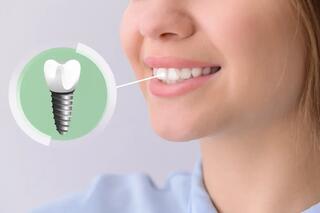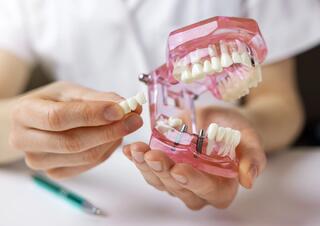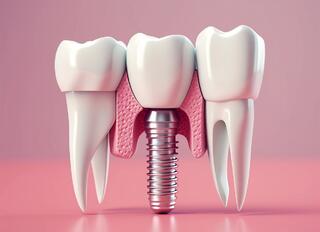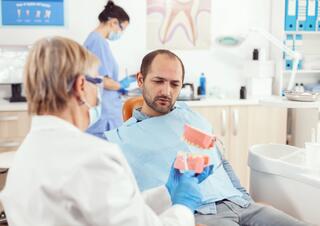At Dental Portal, we address the issue of missing back teeth and the methods of replacing them. We'll start by explaining what a terminal defect is and why it requires a special approach. The main solutions include dental implants, partial dentures, and removable dentures. Dental implants offer reliability and aesthetics, while partial dentures are convenient and long-lasting. Removable partial dentures are a cost-effective option but with limitations in durability. Find out which method is right for you!
What Is a Terminal Defect?
A terminal defect refers to the absence of the last teeth on one of the jaws. This type of defect is categorized separately because a traditional dental bridge cannot be placed, due to the lack of a support tooth on one side.
When it comes to alternative methods of tooth restoration, there are several options. A well-grounded decision can only be made after preliminary staged diagnostics and an evaluation of the patient's oral health at the time of prosthetics.
Dental Implantation
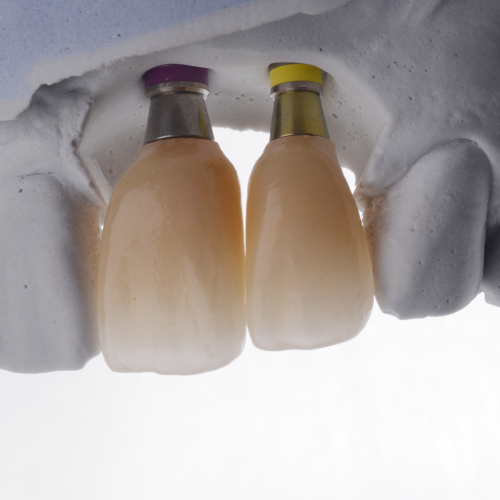
Dental implantation is the best method for correcting a terminal defect if the last teeth are missing. During surgery, artificial titanium roots (implants) are inserted into the place of the missing teeth. After the implants have fully integrated into the bone (within 4-6 months), a prosthesis is placed (either individual crowns or a dental bridge).
Advantages of dental implantation:
- Versatility – The procedure can be performed regardless of how many teeth are missing.
- Physiological benefits – It eliminates the need to file down healthy teeth and prevents bone tissue atrophy in the area of the defect.
- Secure attachment – The prosthesis does not press on the gum or fall out of the mouth.
- High aesthetics – The artificial teeth are identical to natural ones.
- Durability – Implants can last a lifetime, and the prosthesis up to 25 years.
Disadvantages
- Include the need for a full surgical procedure and the relatively high cost of treatment.
If there are no posterior teeth, it is better to fix the prosthetic structure on implants—this is the most physiological and reliable way to solve the problem.
Removable Partial Denture (RPD)
A removable partial denture with clasps is a metal arc-shaped device coated with plastic. The appliance is attached to adjacent teeth using clasps (attachments). Two remaining teeth in the row are used for its fixation. Metal-ceramic crowns are first placed on the abutment teeth.
Among the advantages of the RPD, dentists highlight:
- Compactness – the base is smaller in size compared to a full acrylic denture;
- Durability – ensured by the metal framework;
- Reliability and painlessness – the chewing load falls more on the crowns than the gums;
- Ease of use – no special care is required;
- Wear resistance – they last up to 10 years.
The disadvantages include the need to trim the abutment teeth and the progression of bone atrophy under the base.
Removable partial dentures are more suitable for bilateral free-end defects—when the terminal posterior teeth are missing on both sides. In such cases, prosthodontists can ensure the most balanced distribution of the chewing load.
Partial Removable Denture
A partial removable denture consists of a plastic “gum,” tooth replicas, and clasps in the form of hooks or clamps (made of metal or plastic). The structure is secured to natural teeth. This is the fastest and most affordable method of prosthetics for a unilateral free-end defect.
In addition to affordability, the advantages of a full acrylic denture include:
- Versatility – it can be installed at any age;
- Ease of installation – there is no need to trim the abutment teeth for a removable structure;
- Satisfactory aesthetics – if the material’s shade is chosen correctly, the denture is almost unnoticeable in the mouth.
However, the disadvantages of removable dentures outweigh the benefits. They are not durable (lasting up to 5 years), contribute to bone resorption in the defective area, and requires a long adjustment period, and will need special care.
The use of a partial removable denture should be considered only as a temporary solution before installing a removable partial denture or implants.
Choosing an Implant-Supported Prosthesis for Free-End Defects
-
Implant + crown.
An implant is placed in the area of each missing tooth and topped with individual crowns. This is the most preferred option from both a functional and aesthetic standpoint. -
Implants + dental bridge.
This method reduces the number of implants required, making the treatment more affordable. However, a dental bridge is less aesthetically pleasing and does not completely stop the bone resorption process under the prosthesis.
Frequently Asked Questions
Can a prosthesis slip off the last abutment teeth?
If it’s a removable prosthetic device, this is possible.
What are the best prostheses if the last teeth are missing?
The best option is an implant-supported prosthesis made of zirconia. This material is as strong as metal but does not cause allergic reactions.
How should prostheses be cared for in cases of a unilateral free-end defect?
Removable partial dentures and implant-supported prostheses should be cared for just like natural teeth. Removable structures need to be brushed with toothpaste and water twice a day and regularly treated with disinfecting solutions.

